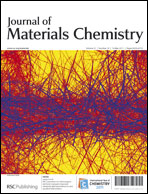A facile solvothermal synthesis of hierarchical Sb2Se3nanostructures with high electrochemical hydrogen storage ability†
Abstract
Sb2Se3 carpenterworm-like hierarchical structures composed of numerous sheet-like crystals with a diameter of ca.1 μm and a thickness of ca.40 nm have been fabricated by a simple


 Please wait while we load your content...
Please wait while we load your content...